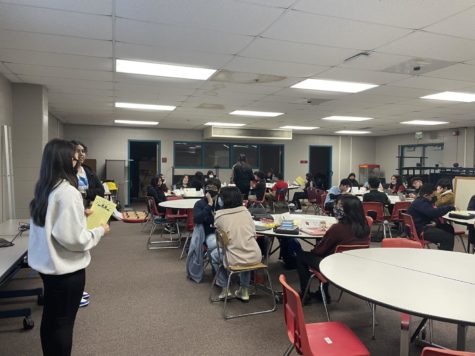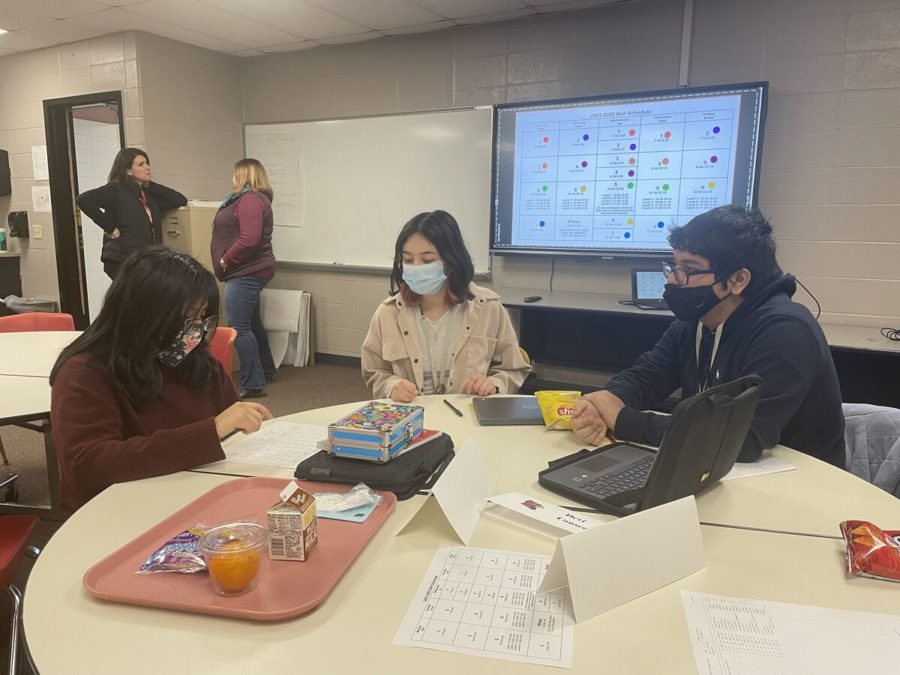Photo contributed by Enzo Zavaleta
Juniors Devi Canseco Lopez and Enzo Zavaleta talk to Ashley, eighth grader, about how different the schedules are compared to middle school on Feb. 25. The mentors spend about an hour working with them once a month at SMS.
Guiding steps
Hispanic SHS students provide resources for young adults to adjust to high school life
April 29, 2022
English
After noticing concerning numbers in the graduation rates of hispanic students at SHS, assistant principal Amy Boone, collaborating with ELL administrator Lisa Netsch, SMS administrator David Walpole and spanish teacher Jamie Marshall, sought to improve this problem.
A few selected juniors are a part of a newly introduced program at SHS called the “Latinx Program.” Their main goal is to help increase the graduation rates of Hispanic students by helping middle schoolers have a smoother transition into high school.
“We felt as though they needed greater mentorship and guidance than we had been giving them in the past,” Marshall said.
At the request of Boone, Marshall was asked to help with the program due to her prior experience administrating. Before becoming a teacher, she was a dean at the middle school. Now, using her current position as a level 3 Spanish teacher, she promoted the program to her students and recommended them to become mentors for the program.
One of these students, junior Michelle Torres, was inspired to join the program because she was aware of how fortunate she was. She was able to enter high school with good opportunities and the information that she needed to be successful. Torres wanted other students to have that opportunity as well.
“I wanted to help students and show them it’s possible to manage your time and do a lot of things,” Torres said.
Through the promotion of the program, Torres, among other students like Enzo Zavaleta and Dariely Raudales, decided to apply to become mentors for the program. The application process of becoming a mentor consisted of filling out a form that contained certain requirements.
Since the program was to help Hispanic students, mentors had to be able to speak a certain level of Spanish in order to get this position. Students also were expected to have good behavior, attendance and grades.
The program initially started after winter break. During this time, junior mentors visited the middle school for the first time to meet the students involved in the program. Some of the middle school students had an easier time speaking English, while others felt more comfortable speaking Spanish. So, mentors often switched the two to ensure that students understood.
In order to help the students feel comfortable around the mentors and around each other, mentors often had students participate in ice breakers. These challenges were usually planned in advance during a group meeting held during ipass.
“I personally enjoy them cause it makes what would usually be an awkward situation into something fun,” Zavaleta said.
The mentors informed the students of a variety of things about SHS. They were able to bring the students to the high school, where they received a tour detailing what the life of a high schooler looked like, as well as terms for certain areas around school and shortcuts to classes.
After each meeting with the students, mentors are expected to fill out a google form survey detailing their visit. Mentors answer questions about their experience at the middle school and comment on any concerns they might have.
“I think it allows us to self-reflect because we can note what we want to work on with them and come up with new ideas for future meetings,” Raudales said.
Due to this being the first year, there are still a lot of trial and errors within the program. The hope for next year is that they can start the program from the beginning of the school year. This year, only about 28 students were chosen by the middle school to participate in this program, but Marshall said she hopes that more students will be able to join the program in the future.
One change that the program wants to take advantage of is the mixed-grade ipass. The current juniors, who will be seniors next year, will be placed in the same Ipass class as current 8th graders, who will be freshmen next year. This immersion will allow the students to be more comfortable to see a familiar face, ultimately providing a smoother transition into high school life.
“I’m really looking forward to see how the students adapt and take into consideration everything we’ve told them. I am excited to see them again as freshmen next year,” Zavaletta said.

Spanish
Después de notar un número preocupante de graduaciónes en los estudiantes hispanos en SHS, la subdirectora Amy Boone, en colaboración con la administradora de ELL, Lisa Netsch, el administrador de SMS David Walpole y la maestra de español Jamie Marshall, buscaron en mejorar este problema.
Algunos estudiantes en el grado once fueron seleccionados para ser parte de un programa, recientemente introducido en SHS, llamado “Programa Latinx”. Su objetivo principal es ayudar a aumentar los números de graduación de los estudiantes hispanos, al ayudar a los estudiantes de intermedia a tener una transición más fácil a la escuela preparatoria.
“Sentimos que necesitaban más tutoría y orientación de la que les habíamos brindado en el pasado,” dijo Marshall.
A la pedida de Boone, Marshall le pidió que ayudara, debido a su experiencia previa como administradora. Antes de convertirse en una maestra, fue la decana en la escuela intermedia. Ahora, utilizando su puesto actual como maestra de español de nivel tres, promovió el programa entre sus alumnos y los recomendó para que se convirtieran en mentores del programa.
Una de estas estudiantes, Michelle Torres, una alumna del grado once, se inspiró para unirse al programa porque sabía lo afortunada que era. Pudo ingresar a la escuela preparatoria con buenas oportunidades y la información que necesitaba para tener éxito. Torres quería que otros estudiantes también tuvieran estas mismas oportunidades.
“Yo quería ayudar a los estudiantes y mostrarles que es posible administrar su tiempo y hacer muchas cosas,” dijo Torres.
A través de la promoción del programa, Torres, igual a otros estudiantes como Enzo Zavaleta y Dariely Raudales, decidieron aplicar para convertirse en mentores del programa. El proceso de solicitud para convertirse en mentor consistía en llenar un formulario que contenía ciertos requisitos.
Como el programa es para ayudar estudiantes hispanos, los mentores deben de poder hablar un cierto nivel de español para poder obtener este puesto. También se esperaba que los estudiantes tuvieran buen comportamiento, asistencia y calificaciones.
El programa comenzó inicialmente después de las vacaciones de invierno. Durante este tiempo, los mentores visitaron la escuela intermedia por primera vez para conocer a los estudiantes involucrados en el programa. A algunos estudiantes de la escuela intermedia les resultó más fácil hablar inglés, mientras otros se sintieron más cómodos hablando español. Entonces, los mentores a veces cambian de los dos para asegurarse que los estudiantes entendieran.
Para ayudar a los estudiantes sentirse cómodos con los mentores y entre ellos, los mentores hacían que los estudiantes participaran en actividades de rompehielos. Estos retos generalmente se planearon con anticipación entre los estudiantes de la prepa durante una reunión de grupo en iPass.
“Personalmente los disfruto porque convierte lo que normalmente sería una situación incómoda en algo divertido,” dijo Zavaleta.
Los mentores informan a los estudiantes sobre una variedad de cosas sobre SHS. Pudieron llevar a los estudiantes a la escuela preparatoria donde recibieron un recorrido que detalló cómo era la vida de un estudiante de la prepa, así como términos para ciertas áreas alrededor de la escuela y accesos directos a las clases.
Después de cada reunión con los estudiantes se espera que los mentores completen un formulario de Google que detalla su visita. Los mentores responden preguntas sobre su experiencia en la escuela intermedia y comentan cualquier inquietud que puedan tener.
“Yo creo que nos permite relacionarnos con nosotros mismos porque podemos anotar en que queremos trabajar con ellos y pensar en nuevas ideas para futuras reuniones,” dijo Raudales.
Como este es el primer año, todavía hay muchas pruebas y errores dentro del programa. La esperanza para el próximo año es que puedan comenzar el programa desde el comienzo del año escolar. Este año, la escuela intermedia eligió sólo a unos 28 estudiantes para participar en este programa, pero Marshall dijo que espera que más estudiantes puedan unirse al programa en el futuro.
Un cambio que el programa quiere aprovechar es el ipass de grado mixto. Los alumnos del grado once ahora, que serán alumnos del grado doce el próximo año, serán colocados en la misma clase de ipass que los estudiantes de octavo grado, que serán estudiantes de primer año de la preparatoria el próximo año. Esta inversión permitirá que los estudiantes se sientan más cómodos al ver una cara familiar y traer una transición más fluida a la vida en la preparatoria.
“Tengo muchas ganas de ver cómo los estudiantes se adaptan y toman en consideración todo lo que les hemos dicho. Estoy emocionado de verlos nuevamente como estudiantes de primer año el próximo año,” dijo Zavaletta.
